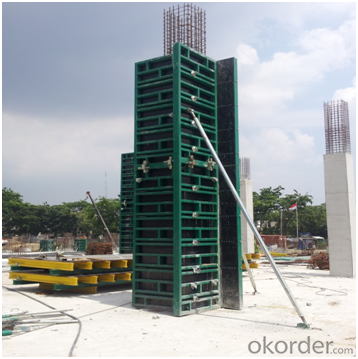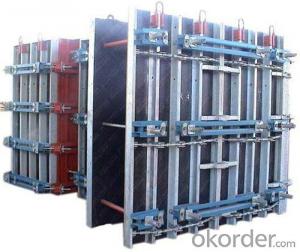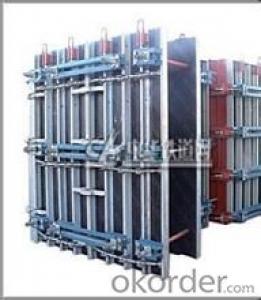Steel Frame Formwork-Column Formwork from CNBM China
- Loading Port:
- China main port
- Payment Terms:
- TT OR LC
- Min Order Qty:
- 1000 m²
- Supply Capability:
- 50000 m²/month
OKorder Service Pledge
OKorder Financial Service
You Might Also Like
1. Structure of Steel Frame Formwork
There is a prizing part designed in the corner, which can help to position and remove formwork easily.
The plywood is screwed on from the back when connecting frame and plywood, so the surface of the finished concrete is perfect.
The formwork series are a complete system with a full set of accessories, and can be set up flexibly according to project demand.
2. Main Features of Steel Frame Formwork
Light weight
High strength
High standardized system
Easy connection with adjustable steel clamp
Convenient and fast corner formwork
Flexible to assemble and application
3. Steel Frame Formwork Images

4. Steel Frame Formwork GK120 Specification
-The steel frame formwork is plywood covered with hollow steel. The plywood is 18 mm thick.
-The frame is highly strengthened, and the wall formwork can bear lateral pressure 60 KN/m2 while the column formwork can bear 80 KN/m2.
-As a standardized system, it is flexible to assemble , wood batten can be filled to satisfy the need f of non-standard size.
-The adjustable steel clamp is convenient to use, and can hold tightly.
-There is a prizing part designed in the corner, which can help to position and remove formwork easily.
-The plywood is screwed on from the back when connecting frame and plywood, so the surface of the finished concrete is perfect.
-The formwork series are a complete system with a full set of accessories, and can be set up flexibly according to project demand.
5. FAQ of Steel Frame Formwork GK120
1) What can we do for you?
.We can ensure the quality of the vinyl banner and avoid extra expenses for customers.
.We can provide you the professional design team.
.We can provide fashionable and newest styles for you.
.We can design the artwork for you.
. Please feel free to customize.
2) What promises can be done by us?
. If interested in Steel Frame Formwork GK120, please feel free to write us for any QUOTE.
. If printing required, please advise asap because the whole set need much more time to complete.
. Please DO check goods when courier knocks your door and contact us asap if any issue.
- Q:How does steel frame formwork prevent the formation of surface defects in the concrete?
- Steel frame formwork is designed to ensure the smooth and accurate placement of concrete during the construction process. It plays a crucial role in preventing the formation of surface defects in the concrete. Firstly, steel frame formwork provides a stable and rigid structure for the concrete to be poured into. This stability prevents any movement or shifting of the formwork during the pouring and curing process. As a result, the concrete is allowed to settle evenly, minimizing the chances of surface defects such as cracks or unevenness. Secondly, steel frame formwork is highly durable and resistant to deformation. Its sturdy construction ensures that it can withstand the pressure exerted by the weight of the concrete without bending or warping. This prevents any potential distortions in the formwork, which could lead to surface imperfections in the concrete. Additionally, steel frame formwork is designed to be smooth and seamless, with minimal joints or gaps. This smooth surface minimizes the likelihood of concrete leakage or seepage, which can cause surface defects such as honeycombing or voids. By effectively containing the concrete within the formwork, steel frame formwork ensures a consistent and defect-free surface finish. Furthermore, steel frame formwork allows for precise control over the concrete pouring process. It can be easily adjusted and leveled, ensuring accurate placement and uniform thickness of the concrete. This precision helps to prevent surface defects such as unevenness or irregularities, resulting in a smoother and more aesthetically pleasing finished product. In conclusion, steel frame formwork prevents the formation of surface defects in concrete by providing stability, durability, smoothness, and precision during the construction process. Its ability to maintain the integrity of the formwork and control the concrete placement ensures a high-quality surface finish without any imperfections.
- Q:Does steel frame formwork require any specific tools for installation?
- Yes, steel frame formwork does require specific tools for installation. Some of the common tools needed include spanners, hammers, clamps, screwdrivers, and wrenches. These tools are necessary for assembling and securing the formwork components together, ensuring stability and structural integrity during concrete pouring and curing processes.
- Q:Can steel frame formwork be used for the construction of retaining walls?
- Yes, steel frame formwork can be used for the construction of retaining walls. Steel frame formwork is a versatile and durable option that is commonly used in construction projects, including retaining walls. It offers a high level of strength and stability, making it suitable for supporting the weight and pressure exerted by the soil and other loads on the retaining wall. Additionally, steel frame formwork allows for precise and accurate shaping of the retaining wall, ensuring a proper fit and alignment. It is also reusable, which makes it a cost-effective choice for projects that require multiple retaining walls. Overall, steel frame formwork is a reliable and efficient solution for the construction of retaining walls.
- Q:What are the different components of a steel frame formwork system?
- A steel frame formwork system consists of several components that work together to provide support and structure during concrete construction processes. These components include: 1. Steel frames: The primary component of a steel frame formwork system is the steel frame itself. These frames are typically made of high-quality steel and are designed to be strong, durable, and able to withstand the weight and pressure exerted by the concrete. 2. Panels: Steel frame formwork systems also include panels that are attached to the steel frames. These panels are typically made of plywood or metal and provide a smooth surface for the concrete to be poured onto. The panels are easy to install, remove, and replace, making them highly efficient and cost-effective. 3. Wedges and clamps: Wedges and clamps are used to secure the panels to the steel frames. Wedges are inserted between the panel and the frame to hold them in place, while clamps provide additional support and stability. These components ensure that the formwork system remains secure and tight during the pouring and curing of the concrete. 4. Adjustable props and supports: To provide additional support and stability, adjustable props and supports are used in a steel frame formwork system. These props and supports are easily adjustable and can be set at different heights to accommodate the desired formwork dimensions. 5. Accessories: Various accessories are also included in a steel frame formwork system, such as corner brackets, alignment clamps, connectors, and anchor bolts. These accessories help to ensure the proper alignment and connection of the formwork components, resulting in a robust and reliable system. Overall, a steel frame formwork system is a versatile and efficient solution for concrete construction projects. Its various components work together to provide a strong and reliable support structure, allowing for the precise pouring and shaping of concrete to create desired structures.
- Q:How does steel frame formwork handle different types of formwork leveling systems?
- Steel frame formwork is designed to accommodate various types of formwork leveling systems. These systems, such as adjustable props or scaffolding, are used to ensure the formwork is leveled and properly supported. The steel frame formwork provides a stable and robust structure that can easily integrate with these leveling systems, allowing for precise and accurate alignment of the formwork components. This enables efficient and effective construction processes, ensuring the desired quality and structural integrity of the finished project.
- Q:Are there any safety precautions that need to be taken when using steel frame formwork?
- Yes, there are several safety precautions that need to be taken when using steel frame formwork. Firstly, it is important to ensure that the steel frame formwork is properly installed and secured to prevent any collapse or instability. This includes checking the connections and supports to ensure they are structurally sound. Additionally, workers should always wear appropriate personal protective equipment (PPE) such as helmets, safety glasses, gloves, and steel-toed boots to protect themselves from any potential hazards on the construction site. It is also crucial to follow the manufacturer's instructions and guidelines for the steel frame formwork to ensure it is being used correctly. This may include maintaining proper spacing and alignment of the formwork components and using the appropriate bracing and supports. Regular inspections of the steel frame formwork should be conducted to identify any signs of damage or wear. Any damaged or deteriorated components should be immediately replaced to maintain the integrity and safety of the formwork system. Furthermore, it is important to consider the weight and load-bearing capacity of the steel frame formwork. Overloading the formwork can lead to collapse or instability, so it is essential to adhere to the specified weight limits and distribute the load evenly. Finally, communication and coordination among the construction team are crucial when using steel frame formwork. Clear instructions and warnings should be given to everyone working in the area to ensure their safety. By following these safety precautions, the risk of accidents and injuries can be significantly reduced when using steel frame formwork.
- Q:Can steel frame formwork be used for the construction of agricultural buildings?
- Indeed, the utilization of steel frame formwork is feasible for the erection of agricultural edifices. With its versatility and durability, steel frame formwork serves as a commendable option for a diverse range of construction undertakings, including agricultural buildings. Its capacity to provide strength, stability, and reusability renders it suitable for agricultural structures necessitating robust and enduring construction materials. Moreover, the ease of assembly and disassembly of steel frame formwork facilitates efficient construction processes within agricultural settings. Thus, whether the objective is to construct barns, sheds, or any other agricultural buildings, opting for steel frame formwork ensures both structural integrity and long-lasting construction.
- Q:What are the different types of support beams used with steel frame formwork?
- Construction projects commonly use several types of support beams in conjunction with steel frame formwork. These beams are crucial for providing stability and strength to the formwork system. Some of the support beams used with steel frame formwork include: 1. H-beams: These beams, shaped like the letter "H," are frequently used and have excellent load-bearing capacity due to their high-strength steel composition. 2. I-beams: Also known as universal beams, these beams have a cross-section shaped like the letter "I" and are ideal for bearing heavy loads. They are commonly employed in large construction projects that require high strength and stability. 3. Box beams: With a rectangular or square cross-section resembling a box, these beams possess a remarkable load-bearing capacity. They are typically utilized in projects where heavy loads need support. 4. Channel beams: Channel beams, or C-beams, have a cross-section shaped like the letter "C." They serve as secondary support beams in steel frame formwork, enhancing strength and stability. Channel beams are often used alongside other types of support beams. 5. Lattice beams: These lightweight and versatile support beams have a lattice-like structure. They are commonly employed in steel frame formwork to span long distances and offer a high level of flexibility. The selection of support beams for steel frame formwork depends on factors such as load requirements, project specifications, and budget constraints. Choosing the appropriate support beams is crucial to ensure the safety and stability of the formwork system throughout construction.
- Q:What are the different types of formwork braces used with steel frame formwork?
- There are several types of formwork braces that are commonly used with steel frame formwork systems. These braces are essential for providing stability and support to the formwork during the concrete pouring process. Some of the different types of formwork braces used with steel frame formwork include: 1. Kicker Braces: These braces are used to provide diagonal support between vertical members of the steel frame formwork. They help to prevent lateral movement and maintain the structural integrity of the formwork. 2. Horizontal Braces: These braces are used to connect the vertical members of the steel frame formwork horizontally. They provide stability and prevent the formwork from twisting or sagging. 3. Cross Braces: These braces are used to provide diagonal support in both directions, forming an "X" shape between the vertical members of the formwork. Cross braces help to distribute the load evenly and prevent any potential buckling or deformation. 4. Tie Rods and Waler Braces: These braces are used in conjunction with tie rods and walers to provide additional support and rigidity to the formwork. Tie rods are threaded rods that are inserted through holes in the vertical members and tightened with nuts to hold the formwork together. Waler braces are horizontal members that connect the tie rods and provide added strength. 5. Adjustable Braces: These braces are used to provide flexibility in adjusting the height and position of the formwork. They are typically made of telescopic tubes or adjustable rods that can be extended or retracted as needed to accommodate different concrete pouring heights. Overall, the different types of formwork braces used with steel frame formwork systems play a crucial role in ensuring the stability and integrity of the formwork during the concrete pouring process. They provide support, prevent deformation, and contribute to the overall quality and strength of the finished concrete structure.
- Q:Are there any limitations to the size or shape of concrete structures that can be formed using steel frame formwork?
- Yes, there are limitations to the size and shape of concrete structures that can be formed using steel frame formwork. One limitation is the maximum height of the structure that can be achieved. Steel frame formwork systems have height restrictions due to the stability and strength of the steel frames. If the structure's height exceeds the maximum limit, additional support systems such as scaffolding or shoring may be required to ensure the stability of the formwork. Another limitation is the complexity of the shape that can be achieved. Steel frame formwork is generally designed to create straight, rectangular or square structures. While some curved or irregular shapes can be achieved, it may require additional modifications or customizations to the formwork system, which can increase the complexity and cost of the construction process. Moreover, the size and weight of the formwork panels can pose limitations. Steel frame formwork panels are typically heavy and can become cumbersome to handle as their size increases. This can make it challenging to maneuver and assemble the formwork panels for larger and more complex structures. Additionally, the availability of skilled labor and equipment can also impact the size and shape limitations of concrete structures formed using steel frame formwork. If the construction project lacks experienced workers or appropriate equipment, it may be difficult to handle and assemble the formwork for larger or more intricate structures. In summary, while steel frame formwork offers flexibility in creating concrete structures, there are limitations in terms of height, shape complexity, panel size, and availability of skilled labor and equipment. It is essential to consider these limitations during the design and planning stages of a construction project to ensure the successful implementation of steel frame formwork.
1. Manufacturer Overview |
|
|---|---|
| Location | |
| Year Established | |
| Annual Output Value | |
| Main Markets | |
| Company Certifications | |
2. Manufacturer Certificates |
|
|---|---|
| a) Certification Name | |
| Range | |
| Reference | |
| Validity Period | |
3. Manufacturer Capability |
|
|---|---|
| a)Trade Capacity | |
| Nearest Port | |
| Export Percentage | |
| No.of Employees in Trade Department | |
| Language Spoken: | |
| b)Factory Information | |
| Factory Size: | |
| No. of Production Lines | |
| Contract Manufacturing | |
| Product Price Range | |
Send your message to us
Steel Frame Formwork-Column Formwork from CNBM China
- Loading Port:
- China main port
- Payment Terms:
- TT OR LC
- Min Order Qty:
- 1000 m²
- Supply Capability:
- 50000 m²/month
OKorder Service Pledge
OKorder Financial Service
Similar products
New products
Hot products
Related keywords



























